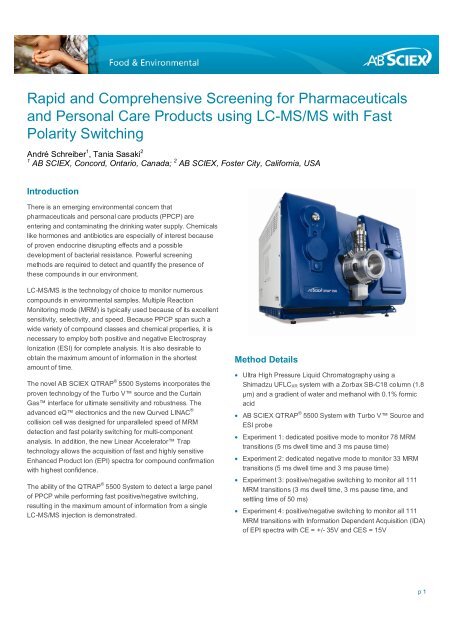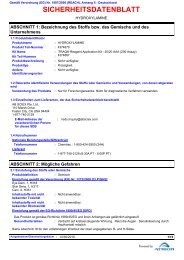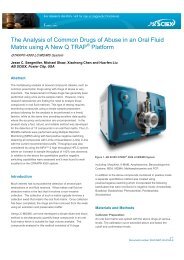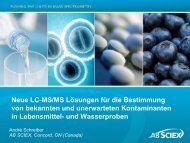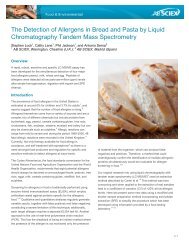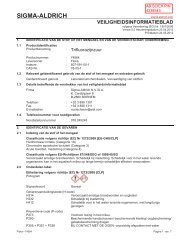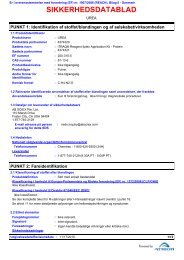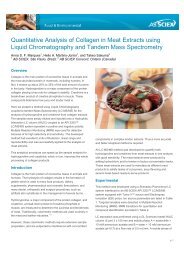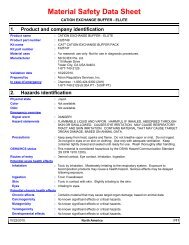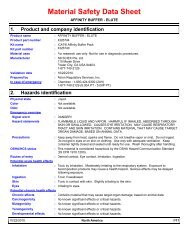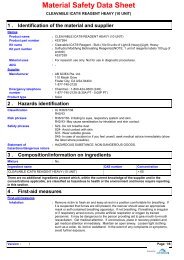Tech Note: Rapid and Comprehensive Screening for ... - AB Sciex
Tech Note: Rapid and Comprehensive Screening for ... - AB Sciex
Tech Note: Rapid and Comprehensive Screening for ... - AB Sciex
You also want an ePaper? Increase the reach of your titles
YUMPU automatically turns print PDFs into web optimized ePapers that Google loves.
<strong>Rapid</strong> <strong>and</strong> <strong>Comprehensive</strong> <strong>Screening</strong> <strong>for</strong> Pharmaceuticals<br />
<strong>and</strong> Personal Care Products using LC-MS/MS with Fast<br />
Polarity Switching<br />
André Schreiber 1 , Tania Sasaki 2<br />
1 <strong>AB</strong> SCIEX, Concord, Ontario, Canada; 2 <strong>AB</strong> SCIEX, Foster City, Cali<strong>for</strong>nia, USA<br />
Introduction<br />
There is an emerging environmental concern that<br />
pharmaceuticals <strong>and</strong> personal care products (PPCP) are<br />
entering <strong>and</strong> contaminating the drinking water supply. Chemicals<br />
like hormones <strong>and</strong> antibiotics are especially of interest because<br />
of proven endocrine disrupting effects <strong>and</strong> a possible<br />
development of bacterial resistance. Powerful screening<br />
methods are required to detect <strong>and</strong> quantify the presence of<br />
these compounds in our environment.<br />
LC-MS/MS is the technology of choice to monitor numerous<br />
compounds in environmental samples. Multiple Reaction<br />
Monitoring mode (MRM) is typically used because of its excellent<br />
sensitivity, selectivity, <strong>and</strong> speed. Because PPCP span such a<br />
wide variety of compound classes <strong>and</strong> chemical properties, it is<br />
necessary to employ both positive <strong>and</strong> negative Electrospray<br />
Ionization (ESI) <strong>for</strong> complete analysis. It is also desirable to<br />
obtain the maximum amount of in<strong>for</strong>mation in the shortest<br />
amount of time.<br />
The novel <strong>AB</strong> SCIEX QTRAP ® 5500 Systems incorporates the<br />
proven technology of the Turbo V source <strong>and</strong> the Curtain<br />
Gas interface <strong>for</strong> ultimate sensitivity <strong>and</strong> robustness. The<br />
advanced eQ electronics <strong>and</strong> the new Qurved LINAC ®<br />
collision cell was designed <strong>for</strong> unparalleled speed of MRM<br />
detection <strong>and</strong> fast polarity switching <strong>for</strong> multi-component<br />
analysis. In addition, the new Linear Accelerator Trap<br />
technology allows the acquisition of fast <strong>and</strong> highly sensitive<br />
Enhanced Product Ion (EPI) spectra <strong>for</strong> compound confirmation<br />
with highest confidence.<br />
The ability of the QTRAP ® 5500 System to detect a large panel<br />
of PPCP while per<strong>for</strong>ming fast positive/negative switching,<br />
resulting in the maximum amount of in<strong>for</strong>mation from a single<br />
LC-MS/MS injection is demonstrated.<br />
Method Details<br />
• Ultra High Pressure Liquid Chromatography using a<br />
Shimadzu UFLCXR system with a Zorbax SB-C18 column (1.8<br />
μm) <strong>and</strong> a gradient of water <strong>and</strong> methanol with 0.1% <strong>for</strong>mic<br />
acid<br />
• <strong>AB</strong> SCIEX QTRAP ® 5500 System with Turbo V Source <strong>and</strong><br />
ESI probe<br />
• Experiment 1: dedicated positive mode to monitor 78 MRM<br />
transitions (5 ms dwell time <strong>and</strong> 3 ms pause time)<br />
• Experiment 2: dedicated negative mode to monitor 33 MRM<br />
transitions (5 ms dwell time <strong>and</strong> 3 ms pause time)<br />
• Experiment 3: positive/negative switching to monitor all 111<br />
MRM transitions (3 ms dwell time, 3 ms pause time, <strong>and</strong><br />
settling time of 50 ms)<br />
• Experiment 4: positive/negative switching to monitor all 111<br />
MRM transitions with In<strong>for</strong>mation Dependent Acquisition (IDA)<br />
of EPI spectra with CE = +/- 35V <strong>and</strong> CES = 15V<br />
p 1
Table 1. Details comparing parameters of the various experiments: Chromatographic peak widths were on the order of 8-10 seconds base-to-base.<br />
Cycle times were adjusted to allow a minimum of 10 scans across the chromatographic peak.<br />
Experiment MRM Transitions Dwell Time (ms) Cycle Time (ms)<br />
Dedicated positive 78 5 624<br />
Dedicated negative 33 5 264<br />
Polarity switching 111 3 766<br />
Results<br />
Intensity, cps<br />
Intensity, cps<br />
XIC of +MRM (78 pairs): 235.2/86.1 Da ID: Lidocaine_1 from Sample 3 of Dedicated Posit... Max. 1.2e6 cps.<br />
1.20e6<br />
1.00e6<br />
8.00e5<br />
6.00e5<br />
4.00e5<br />
2.00e5<br />
0.00<br />
0.0 1.0 2.0 3.0 4.0 5.0 6.0 7.0 8.0 9.0<br />
Time, min<br />
10.0 11.0 12.0 13.0 14.0 15.0 16.0<br />
XIC of +MRM (78 pairs): Exp 1, 235.2/86.1 Da ID: Lidocaine_1 from Sample 3 of Pos Neg... Max. 1.1e6 cps.<br />
1.20e6<br />
1.00e6<br />
8.00e5<br />
6.00e5<br />
4.00e5<br />
2.00e5<br />
Dedicated<br />
positive polarity<br />
Positive<br />
negative switching<br />
Figure 1. LC-MS/MS analysis in positive polarity: Comparison of a data<br />
acquired using a dedicated positive mode acquisition method (top) versus<br />
a method that utilized positive/negative switching (bottom)<br />
Intensity, cps<br />
Intensity, cps<br />
Figure 1a. Zoomed in view of Figure 1<br />
6.5<br />
6.5<br />
0.00<br />
0.0 1.0 2.0 3.0 4.0 5.0 6.0 7.0 8.0 9.0<br />
Time, min<br />
10.0 11.0 12.0 13.0 14.0 15.0 16.0<br />
XIC of +MRM (78 pairs): 235.2/86.1 Da ID: Lidocaine_1 from Sample 3 of Dedicated Posit... Max. 1.2e6 cps.<br />
4.0e5<br />
3.0e5<br />
2.0e5<br />
1.0e5<br />
0.0<br />
2.0 3.0 4.0 5.0 6.0 7.0 8.0<br />
Time, min<br />
9.0 10.0 11.0 12.0 13.0 14.0<br />
XIC of +MRM (78 pairs): Exp 1, 235.2/86.1 Da ID: Lidocaine_1 from Sample 3 of Pos Neg... Max. 1.1e6 cps.<br />
4.0e5<br />
3.0e5<br />
2.0e5<br />
1.0e5<br />
0.0<br />
Dedicated<br />
positive polarity<br />
Positive<br />
negative switching<br />
2.0 3.0 4.0 5.0 6.0 7.0 8.0 9.0 10.0 11.0 12.0 13.0 14.0<br />
Time, min<br />
Intensity, cps<br />
Intensity, cps<br />
XIC of -MRM (33 pairs): 307.0/160.9 Da ID: Warfarin_1 from Sample 7 of Dedicated Nega... Max. 3.0e6 cps.<br />
2.5e6<br />
2.0e6<br />
1.5e6<br />
1.0e6<br />
5.0e5<br />
0.0<br />
2 4 6 8<br />
Time, min<br />
10 12 14 16<br />
XIC of -MRM (33 pairs): Exp 2, 307.0/160.9 Da ID: Warfarin_1 from Sample 7 of Pos Neg... Max. 2.7e6 cps.<br />
2.7e6<br />
2.5e6<br />
2.0e6<br />
1.5e6<br />
1.0e6<br />
5.0e5<br />
0.0<br />
Dedicated<br />
negative polarity<br />
Positive<br />
negative switching<br />
2 4 6 8 10 12 14 16<br />
Time, min<br />
Figure 2. LC-MS/MS analysis in negative polarity: Comparison of a data<br />
acquired using a dedicated negative mode acquisition method (top)<br />
versus a method that utilized positive/ negative switching (bottom)<br />
Intensity, cps<br />
Intensity, cps<br />
XIC of -MRM (33 pairs): 307.0/160.9 Da ID: Warfarin_1 from Sample 7 of Dedicated Nega... Max. 3.0e6 cps.<br />
3.0e5<br />
2.5e5<br />
2.0e5<br />
1.5e5<br />
1.0e5<br />
5.0e4<br />
0.0<br />
7.0 7.5 8.0 8.5 9.0 9.5 10.0 10.5 11.0<br />
Time, min<br />
11.5 12.0 12.5 13.0 13.5 14.0 14.5 15.0<br />
XIC of -MRM (33 pairs): Exp 2, 307.0/160.9 Da ID: Warfarin_1 from Sample 7 of Pos Neg... Max. 2.7e6 cps.<br />
3.0e5<br />
2.5e5<br />
2.0e5<br />
1.5e5<br />
1.0e5<br />
5.0e4<br />
0.0<br />
Dedicated<br />
negative polarity<br />
Positive<br />
negative switching<br />
7.0 7.5 8.0 8.5 9.0 9.5 10.0 10.5 11.0 11.5 12.0 12.5 13.0 13.5 14.0 14.5 15.0<br />
Time, min<br />
Figure 2a. Zoomed in view of Figure 2<br />
11.8<br />
p 2
Data from the dedicated positive <strong>and</strong> negative experiment were<br />
compared to data from the polarity switching experiment. Peak<br />
areas <strong>and</strong> signal-to-noise (S/N) were compared, as well as %CV<br />
of the peak areas.<br />
Intensity, cps<br />
Intensity, cps<br />
Intensity, cps<br />
Intensity, cps<br />
XIC of +MRM (78 pairs): 195.5/13... Max. 2.3e4 cps.<br />
2.0e4<br />
1.0e4<br />
(+) Caffeine<br />
6.9<br />
1.9e4<br />
(+/-)Caffeine<br />
S/N = 24.7 1.0e4 S/N = 20.0<br />
0.0<br />
5.0 5.5 6.0 6.5 7.0 7.5<br />
Time, min<br />
8.0 8.5<br />
XIC of +MRM (78 pairs): 235.2/86... Max. 1.1e6 cps.<br />
1.00e6<br />
5.00e5<br />
(+) Lidocaine<br />
6.5<br />
1.0e6<br />
(+/-) Lidocaine<br />
S/N = 705<br />
5.0e5<br />
S/N = 922<br />
0.00<br />
4.5 5.0 5.5 6.0 6.5 7.0<br />
Time, min<br />
7.5 8.0 8.5<br />
XIC of +MRM (78 pairs): 213.1/72... Max. 9.1e4 cps.<br />
9.1e4<br />
5.0e4<br />
0.0<br />
9.0 9.5 10.0 10.5 11.0<br />
Time, min<br />
11.5 12.0 12.5<br />
XIC of -MRM (33 pairs): 312.9/15... Max. 2.8e5 cps.<br />
2.8e5<br />
2.0e5<br />
1.0e5<br />
0.0<br />
Variations between the sets of data were minimal, demonstrating<br />
that no significant loss of data quality was observed when a<br />
positive/negative switching method was used versus a dedicated<br />
method (see Figure 1-4).<br />
Dedicated polarity Positive negative switching<br />
XIC of +MRM (78 pairs): Exp 1, 1... Max. 1.9e4 cps.<br />
0.0<br />
5.0 5.5 6.0 6.5 7.0 7.5<br />
Time, min<br />
8.0 8.5<br />
XIC of +MRM (78 pairs): Exp 1, 2... Max. 1.0e6 cps.<br />
Figure 3. Comparison of S/N <strong>for</strong> representative analytes: Data from the dedicated positive or negative experiment is shown on the left <strong>and</strong> data acquired<br />
using a positive/negative switching experiment is shown on the right. No significant degradation of data quality was observed when using the polarity<br />
switching experiment<br />
Intensity, cps<br />
Intensity, cps<br />
6.9<br />
6.5<br />
0.0<br />
4.5 5.0 5.5 6.0 6.5 7.0<br />
Time, min<br />
7.5 8.0 8.5<br />
XIC of +MRM (78 pairs): Exp 1, 2... Max. 9.1e4 cps.<br />
10.7<br />
(+) Chlorotoluron<br />
9.1e4<br />
10.7<br />
(+/-) Chlorotoluron<br />
S/N = 52.6 5.0e4 S/N = 48.8<br />
11.5 12.0 12.5 13.0 13.5 14.0 14.5 15.0<br />
Time, min<br />
Intensity, cps<br />
0.0<br />
9.0 9.5 10.0 10.5 11.0<br />
Time, min<br />
11.5 12.0 12.5<br />
XIC of -MRM (33 pairs): Exp 2, 3... Max. 1.9e5 cps.<br />
(-) Triclocarban<br />
13.3<br />
1.9e5<br />
13.3<br />
(+/-) Triclocarban<br />
S/N = 869<br />
1.0e5<br />
S/N = 592<br />
Intensity, cps<br />
0.0<br />
11.5 12.0 12.5 13.0 13.5 14.0 14.5 15.0<br />
Time, min<br />
p 3
Percent of compounds<br />
Percent of compounds<br />
60<br />
50<br />
40<br />
30<br />
20<br />
10<br />
0<br />
90<br />
80<br />
70<br />
60<br />
50<br />
40<br />
30<br />
20<br />
10<br />
0<br />
Figure 4. Comparison of reproducibility: Peak areas of all analytes<br />
monitored across five replicate injections <strong>and</strong> the %CV <strong>for</strong> each analyte<br />
were determined. The charts compare the percent of compounds having<br />
coefficients of variation in the various ranges. %CV from the dedicated<br />
positive or negative experiments were compared with the %CV from a<br />
positive/negative switching experiment. Even with increased acquisition<br />
cycle times in the switching experiment, %CV of


